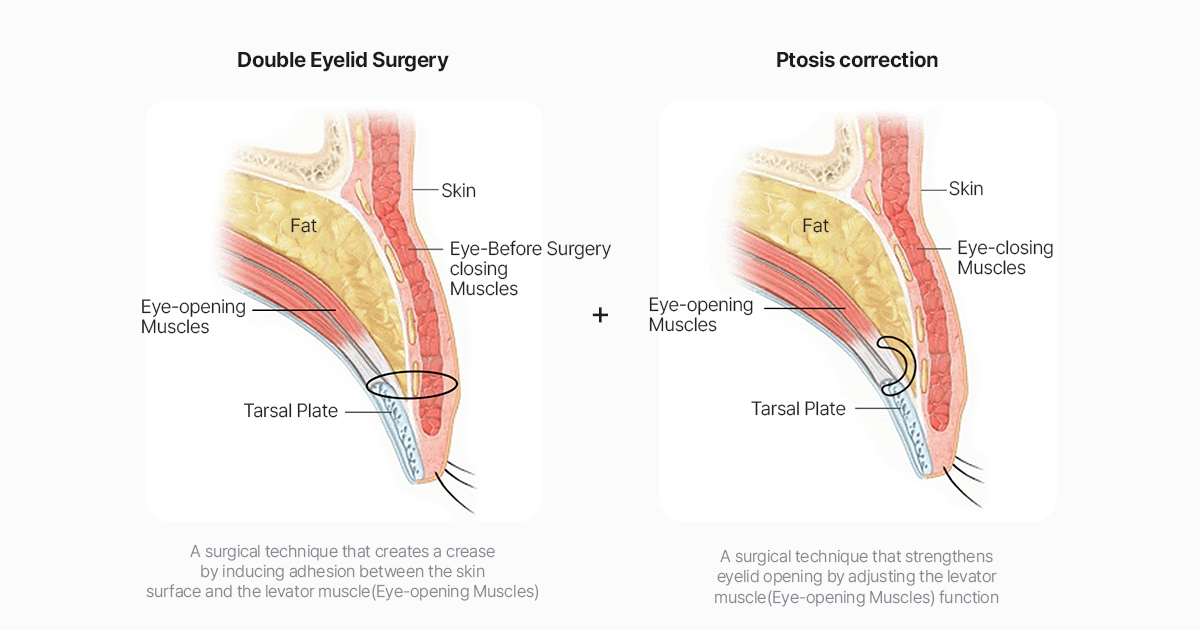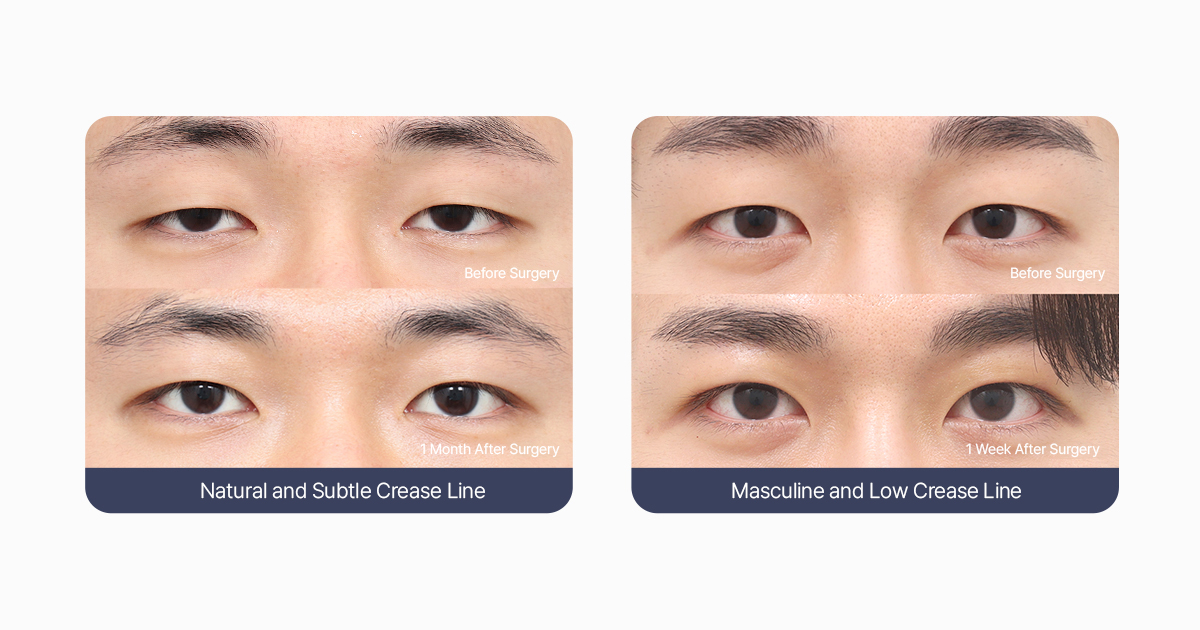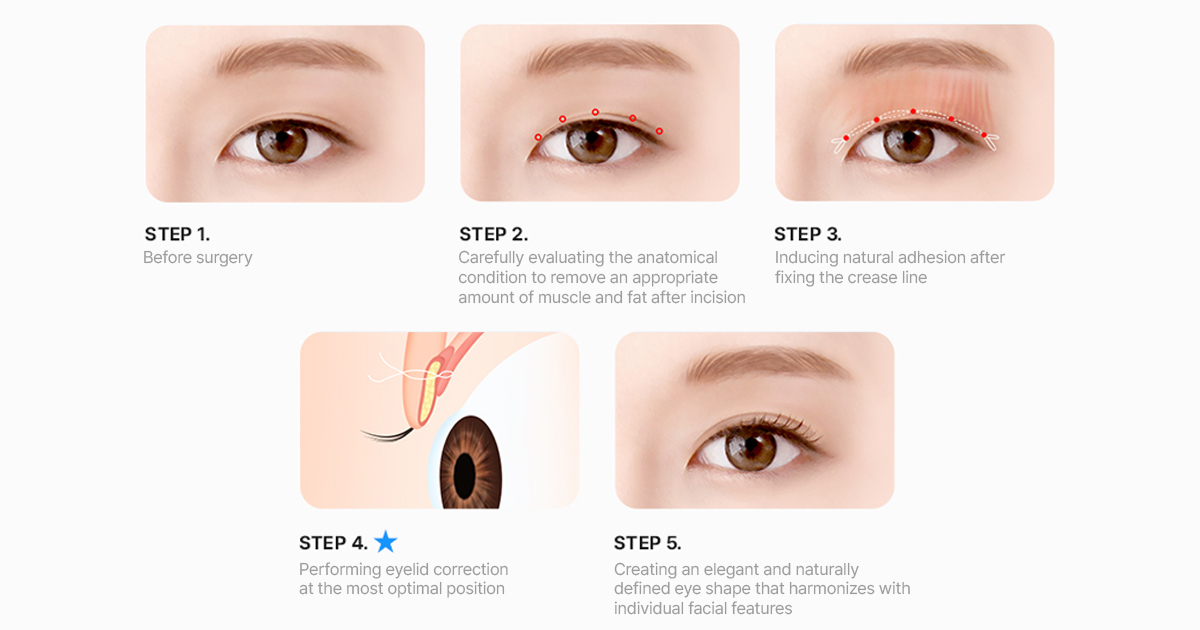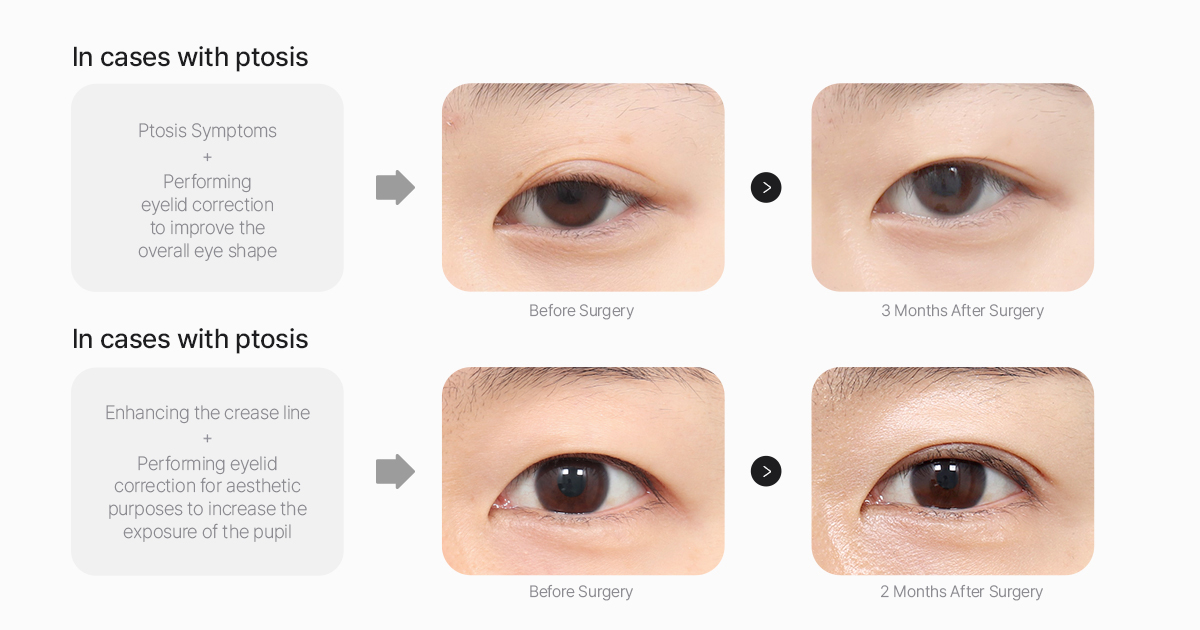Title
Do you know the difference between eyelid correction and double eyelid surgery?Date
2025-11-17Views
172
Medical Column

This is Dr. Do Gyeong-Hyeon, board certified plastic surgeon at AB Plastic Surgery.
The eyes play a central role in shaping the first impression, and even subtle changes in the eye shape can significantly influence the overall appearance. Many individuals consider eyelid correction to improve a tired or sleepy look. However, selecting a surgical option without sufficient consultation or information may lead to results that do not harmonize with the facial features.
Today's discussion provides a detailed explanation of eyelid correction and outlines how to identify the most suitable eyelid surgery method for each individual.
Q. What is the difference between ptosis correction and double eyelid surgery?
Many individuals visit the clinic without clearly understanding the difference between ptosis correction and double eyelid surgery. Simply put, these two procedures serve different purposes.
Double eyelid surgery, commonly referred to as double eyelid creation, focuses on cosmetic enhancement by forming a double eyelid crease to make the eyes appear larger and more defined. This procedure creates an adhesion between the skin and the tarsal plate, or between the skin and the tissues of the upper eyelid, and is customized based on the eyelid skin condition and anatomical structure.
In contrast, ptosis correction is a functional procedure that adjusts the tension of the levator palpebrae superioris or Müllers muscle, the muscles responsible for lifting the upper eyelid. The primary goal is to correct ptosis, a condition characterized by weak eyelid lifting power, thereby enhancing eyelid opening, reducing visual fatigue, and improving the field of vision. It may also contribute to a more defined eye shape as a secondary aesthetic benefit.
The anatomical differences between these two procedures are shown in the image below.

Q. Is ptosis correction possible without double eyelid surgery?
It is possible, but this approach may lead to somewhat unnatural results.
When ptosis correction is performed without creating a double eyelid crease, the lifting power of the upper eyelid can improve, but the drooping skin may still cover the eyelashes and irritate the cornea, and in severe cases may even cause corneal damage. To minimize complications and achieve natural results, it is generally advisable to allow the skin to fold naturally and form a subtle double eyelid line.
For those who prefer a mono-lid appearance, a very low crease can be designed to create an inner fold that maintains a mono-lid-like look.
This approach is particularly suitable for male patients seeking ptosis correction without a prominent double eyelid, as a low inner fold can provide a natural appearance while addressing both functional and aesthetic needs.

Q. What is the difference between non-incisional and incisional ptosis correction?
Ptosis correction is a procedure that improves eyelid function by adjusting the muscles responsible for lifting the upper eyelid. Depending on the condition of the eyelids and the specific needs of each patient, either non-incisional ptosis correction or incisional ptosis correction may be selected. These approaches differ in their indications, technical methods, recovery time, and final outcomes, and understanding these distinctions is essential.
1. Non-incisional ptosis correction

Non-incisional ptosis correction is a procedure that enhances eyelid lifting power by adjusting the relevant muscles through small puncture sites without cutting the skin. The technique primarily focuses on the Müllers muscle, strengthening eyelid elevation by overlapping or shortening the muscle. Sutures are used to connect the muscle to the tarsal plate, allowing adjustment of muscle length and improving the overall lifting force.
Indications
- Thin eyelid skin with minimal sagging
- Eyes with little fat
- Mild to moderate ptosis
- Patients seeking rapid recovery and minimal invasiveness
Advantages
- No skin incision, resulting in no visible scarring
- Reduced swelling and bruising with faster recovery, typically within three to seven days
- Can be performed relatively easily under local anesthesia
Disadvantages
- Limited effectiveness in cases with thick skin or significant fat
- May be insufficient for severe ptosis or pronounced sagging
- Direct visualization and adjustment of the skin and muscle layers are limited
2. Incisional ptosis correction

Incisional ptosis correction involves creating an incision in the upper eyelid to expose the levator palpebrae superioris or Müllers muscle, allowing direct adjustment of its length or fixation to the tarsal plate. During this process, excess skin and fat can be removed, and the eyelid muscles and surrounding tissues can be refined with precision. This method corrects muscle tension while also addressing issues related to skin laxity.
Indications
- Thick eyelid skin with significant fat
- Severe sagging or advanced ptosis
- Patients seeking a more detailed and stable result
Advantages
- Direct visualization of muscles and tissues enables precise correction
- Simultaneous treatment of excess skin, fat, and muscle issues
- Provides more dramatic and long lasting results
Disadvantages
- Swelling and bruising may last longer compared with the non-incisional method, with an average recovery period of one to two weeks
- Possibility of a visible scar due to the incision, although it generally fades over time
- Requires a longer procedure time and recovery period
|
Comparison Item |
Non-incisional Ptosis Correction |
Incisional Ptosis Correction |
|
Invasiveness |
Low |
High |
|
Ideal Candidates |
Thin skin, mild ptosis |
Thick skin, eyes with significant fat, severe ptosis |
|
Recovery Period |
Fast, approximately three to seven days |
Relatively slower, approximately one to two weeks |
|
Longevity of Results |
May be mild or limited |
Provides stable and more dramatic results |
|
Technical Complexity |
Relatively simple |
Requires precision and advanced surgical skill |
In conclusion, the non-incisional method is suitable for patients seeking minimal invasiveness and a quicker recovery, and it is effective for eyelids with thin skin and little fat. In contrast, the incisional method is appropriate for those with thicker skin, significant fat, or a desire for more refined and dramatic improvement. Selecting the appropriate technique depends on the individual eyelid condition and personal treatment goals.
Q. Is ptosis correction performed only when ptosis is present?
Ptosis correction is highly effective for enhancing the clarity and overall aesthetics of the eyes, regardless of the presence of ptosis, and is often performed together with double eyelid surgery. When ptosis is present, the procedure corrects the underlying condition while simultaneously improving the overall eyelid shape. In cases without ptosis, the procedure is performed for cosmetic purposes to refine the eyelid crease and increase the exposure of the pupil for a brighter appearance.

An important point is that the intensity of correction and the height of the eyelid crease must be carefully adjusted based on each individual’s condition. This requires substantial surgical experience and advanced technical skill, so indiscriminate ptosis correction should be avoided.
For this reason, anyone considering ptosis correction should receive thorough consultation at a qualified medical institution to determine the most appropriate surgical method. This careful approach helps ensure safe and satisfactory outcomes.
Has the explanation on the differences between ptosis correction and double eyelid surgery been helpful?
For additional inquiries regarding ptosis correction, please contact AB Plastic Surgery at +82-10-9674-1298 or reach out via WhatsApp using the same number to receive a detailed consultation.

|
Writer Dr. Do Gyeong-Hyeon, AB Plastic Surgery |
#Ptosis_correction
#Double_Eyelids_Surgery
#Non-Incisional_Ptosis_Correction
# Incisional_Ptosis_Correction





